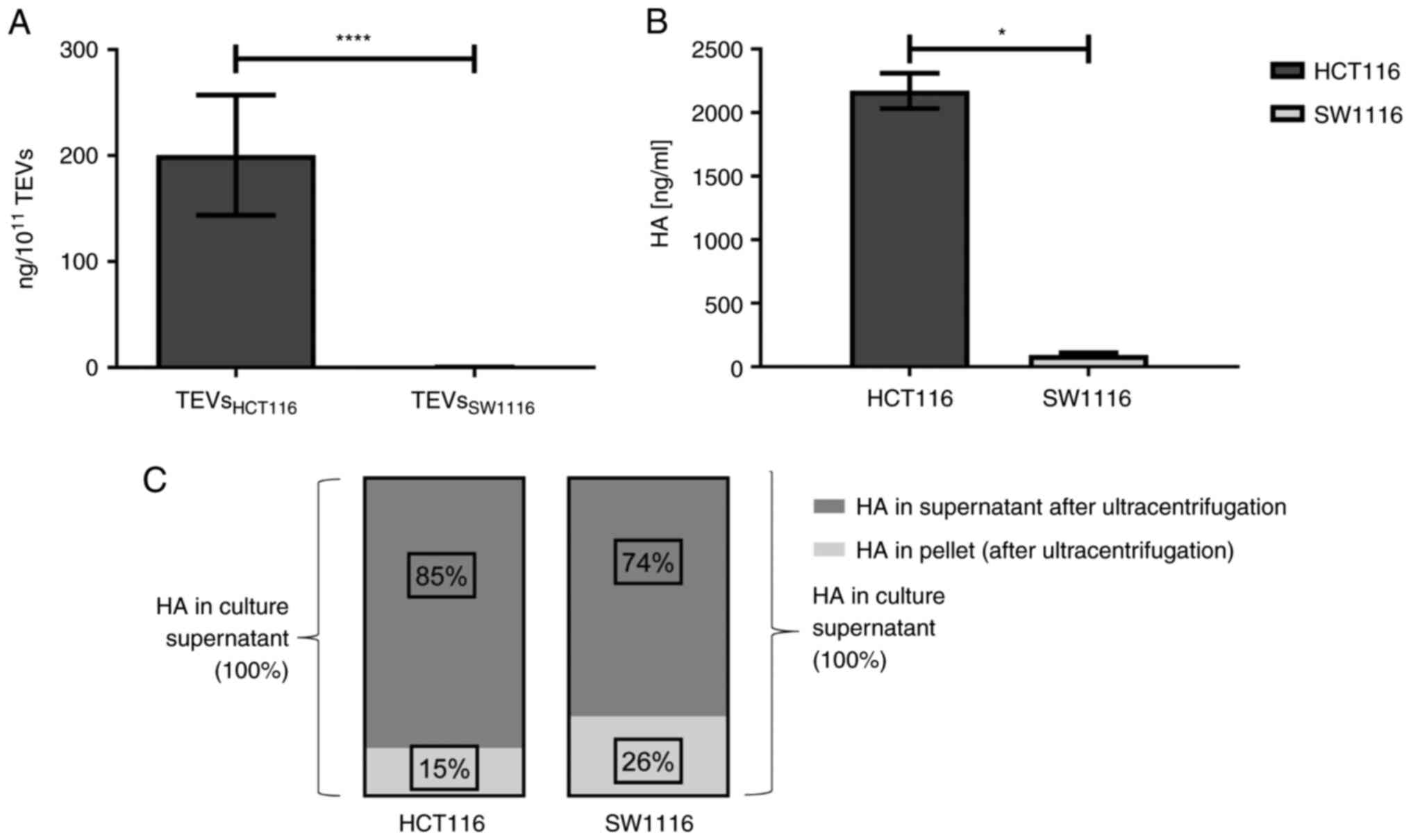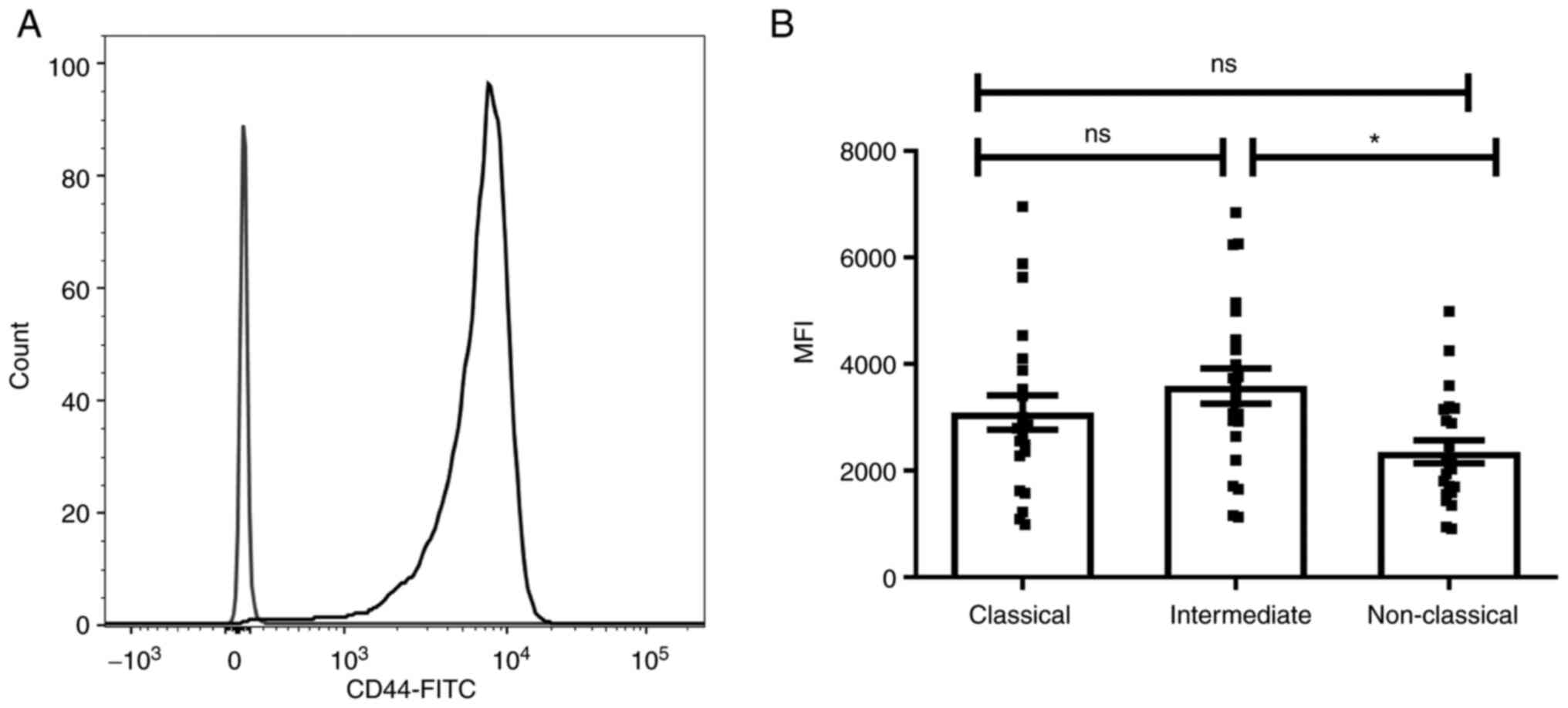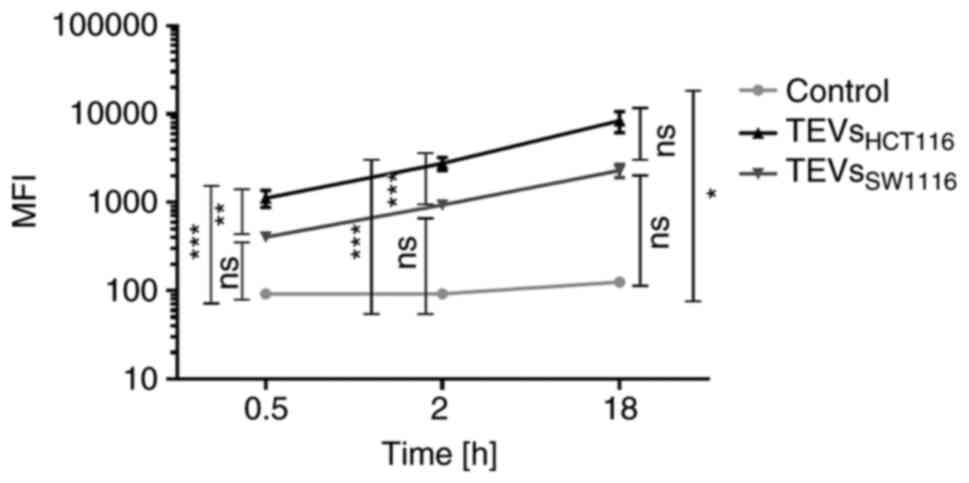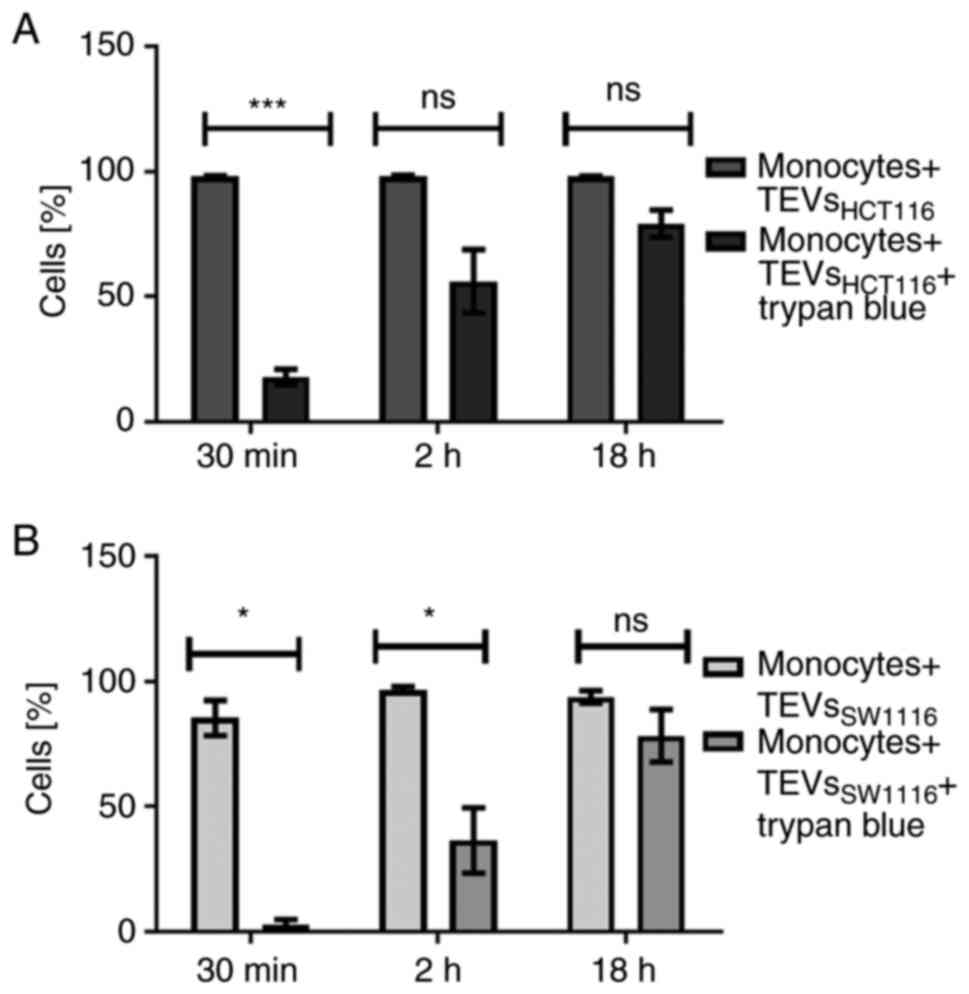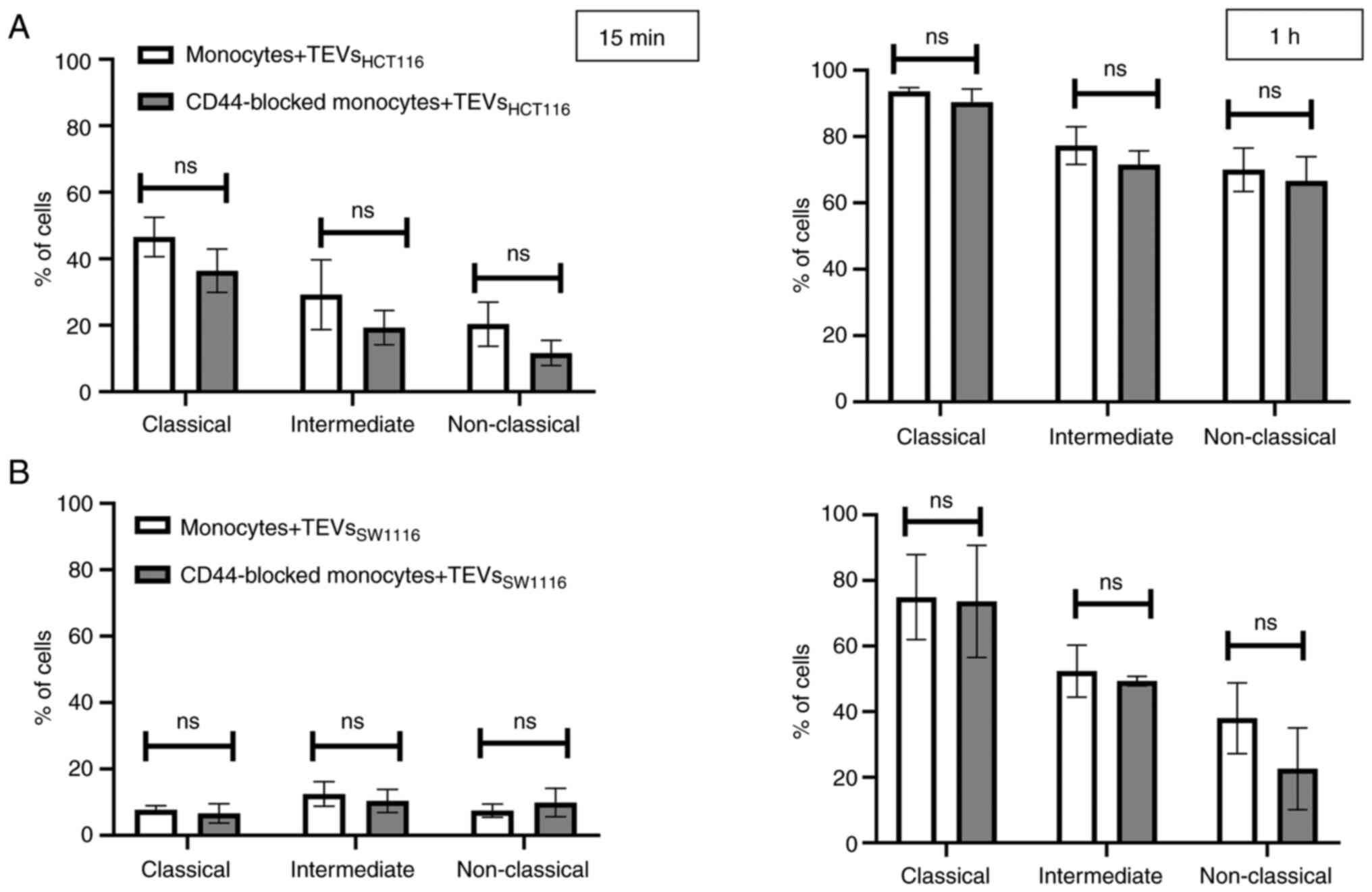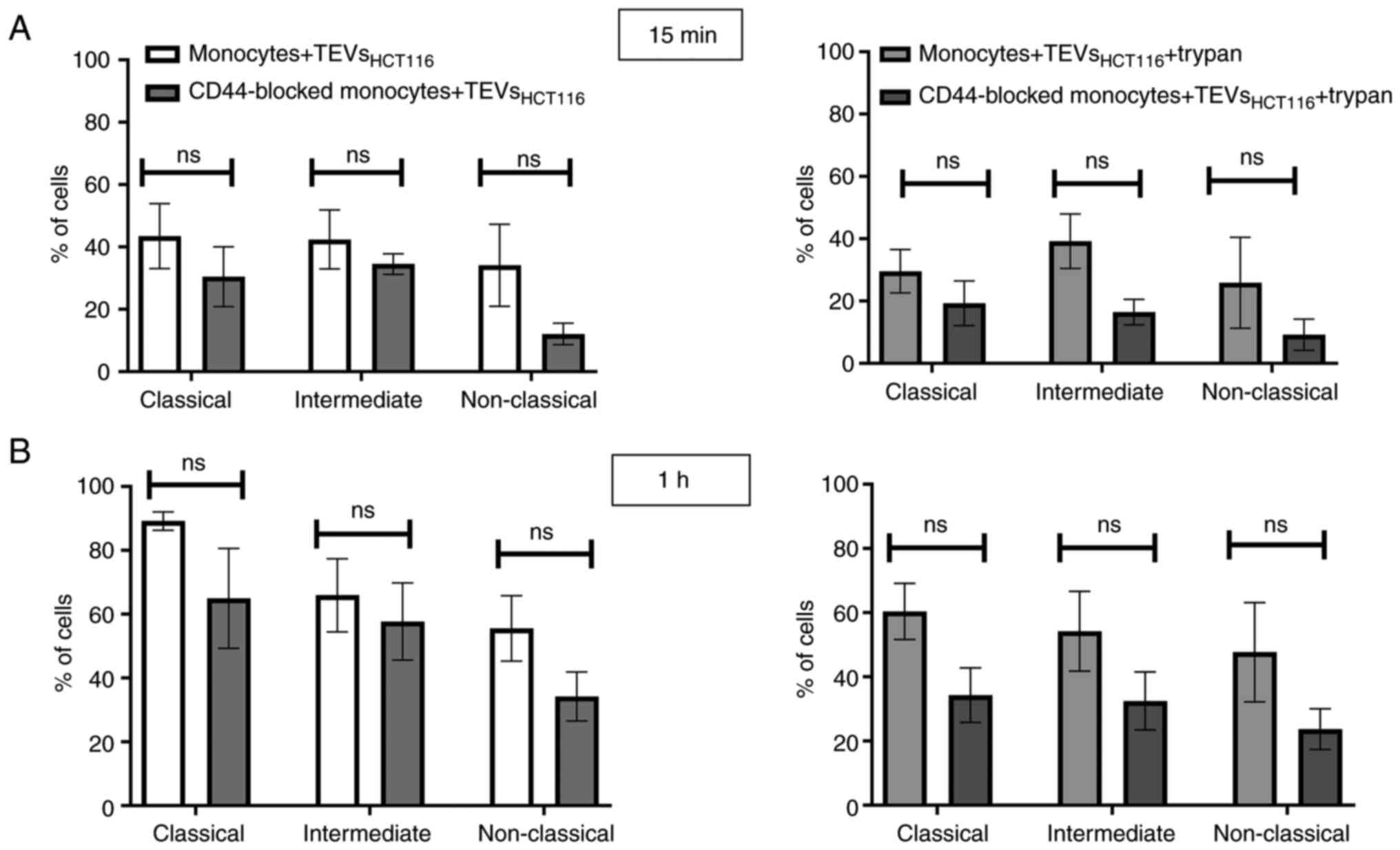|
1
|
Ping JYX, Neupane YR and Pastorin G:
Extracellular Vesicles and Their Interplay with Biological
Membranes. Manash KP: Extracellular Vesicles Role in Diseases,
Pathogenesis and Therapy. IntechOpen Series Physiology. Volume 13.
IntechOpen; London, UK: pp. 27–59. 2021
|
|
2
|
Buzas EI: Opportunities and challenges in
studying the extracellular vesicle corona. Nat Cell Biol.
24:1322–1325. 2022. View Article : Google Scholar : PubMed/NCBI
|
|
3
|
Chen Y, Xie Y, Xu L, Zhan S, Xiao Y, Gao
Y, Wu B and Ge W: Protein content and functional characteristics of
serum-purified exosomes from patients with colorectal cancer
revealed by quantitative proteomics. Int J Cancer. 140:900–913.
2017. View Article : Google Scholar : PubMed/NCBI
|
|
4
|
Glass SE and Coffey RJ: Recent advances in
the study of extracellular vesicles in colorectal cancer.
Gastroenterology. 163:1188–1197. 2022. View Article : Google Scholar : PubMed/NCBI
|
|
5
|
Xiao Y, Zhong J, Zhong B, Huang J, Jiang
L, Jiang Y, Yuan J, Sun J, Dai L, Yang C, et al: Exosomes as
potential sources of biomarkers in colorectal cancer. Cancer Lett.
476:13–22. 2020. View Article : Google Scholar : PubMed/NCBI
|
|
6
|
Russell AE, Sneider A, Witwer KW, Bergese
P, Bhattacharyya SN, Cocks A, Cocucci E, Erdbrügger U, Falcon-Perez
JM, Freeman DW, et al: Biological membranes in EV biogenesis,
stability, uptake, and cargo transfer: An ISEV position paper
arising from the ISEV membranes and EVs workshop. J Extracell
vesicles. 8:16848622019. View Article : Google Scholar : PubMed/NCBI
|
|
7
|
Czernek L, Chworos A and Duechler M: The
uptake of extracellular vesicles is affected by the differentiation
status of myeloid cells. Scand J Immunol. 82:506–514. 2015.
View Article : Google Scholar : PubMed/NCBI
|
|
8
|
Popēna I, Ābols A, Saulīte L, Pleiko K,
Zandberga E, Jēkabsons K, Endzeliņš E, Llorente A, Linē A and
Riekstiņa U: Effect of colorectal cancer-derived extracellular
vesicles on the immunophenotype and cytokine secretion profile of
monocytes and macrophages. Cell Commun Signal. 16:172018.
View Article : Google Scholar : PubMed/NCBI
|
|
9
|
Baj-Krzyworzeka M, Szatanek R, Weglarczyk
K, Baran J, Urbanowicz B, Brański P, Ratajczak MZ and Zembala M:
Tumour-derived microvesicles carry several surface determinants and
mRNA of tumour cells and transfer some of these determinants to
monocytes. Cancer Immunol Immunother. 55:808–818. 2006. View Article : Google Scholar : PubMed/NCBI
|
|
10
|
Kwok ZH, Wang C and Jin Y: Extracellular
vesicle transportation and uptake by recipient cells: A critical
process to regulate human diseases. Processes (Basel). 9:2732021.
View Article : Google Scholar : PubMed/NCBI
|
|
11
|
Dale DC, Boxer L and Conrad Liles W: The
phagocytes: Neutrophils and monocytes. Blood. 112:935–945. 2008.
View Article : Google Scholar : PubMed/NCBI
|
|
12
|
Uribe-Querol E and Rosales C:
Phagocytosis: Our current understanding of a universal biological
process. Front Immunol. 11:10662020. View Article : Google Scholar : PubMed/NCBI
|
|
13
|
Vachon E, Martin R, Plumb J, Kwok V,
Vandivier RW, Glogauer M, Kapus A, Wang X, Chow CW and Grinstein S:
CD44 is a phagocytic receptor. Blood. 107:4149–4158. 2006.
View Article : Google Scholar : PubMed/NCBI
|
|
14
|
Szatanek R and Baj-Krzyworzeka M: CD44 and
tumor-derived extracellular vesicles (TEVs). Possible gateway to
cancer metastasis. Int J Mol Sci. 22:14632021. View Article : Google Scholar : PubMed/NCBI
|
|
15
|
Ziegler-Heitbrock L, Ancuta P, Crowe S,
Dalod M, Grau V, Hart DN, Leenen PJ, Liu YJ, MacPherson G, Randolph
GJ, et al: Nomenclature of monocytes and dendritic cells in blood.
Blood. 116:e74–e80. 2010. View Article : Google Scholar : PubMed/NCBI
|
|
16
|
Ziegler-Heitbrock L: Blood monocytes and
their subsets: Established features and open questions. Front
Immunol. 6:4232015. View Article : Google Scholar : PubMed/NCBI
|
|
17
|
Fu X and Yin M: Monocytes in tumor: The
perspectives of single-cell analysis. Tumor Discov. 1:42022.
View Article : Google Scholar
|
|
18
|
Turrini R, Pabois A, Xenarios I, Coukos G,
Delaloye JF and Doucey MA: Tie-2 expressing monocytes in human
cancers. Oncoimmunology. 6:e13035852017. View Article : Google Scholar : PubMed/NCBI
|
|
19
|
Cormican S and Griffin MD: Human monocyte
subset distinctions and function: Insights from gene expression
analysis. Front Immunol. 11:10702020. View Article : Google Scholar : PubMed/NCBI
|
|
20
|
Baj-Krzyworzeka M, Weglarczyk K, Szatanek
R, Mytar B, Baran J and Siedlar M: The role of CD44H molecule in
the interactions between human monocytes and pancreatic
adenocarcinoma-derived microvesicles. Folia Histochem Cytobiol.
57:28–34. 2019.PubMed/NCBI
|
|
21
|
Zembala M, Siedlar M, Ruggiero I,
Wieckiewicz J, Mytar B, Mattei M and Colizzi V: The MHC class-II
and CD44 molecules are involved in the induction of tumour necrosis
factor (TNF) gene expression by human monocytes stimulated with
tumor cells. Int J Cancer. 56:269–274. 1994. View Article : Google Scholar : PubMed/NCBI
|
|
22
|
Hyenne V, Ghoroghi S, Collot M, Bons J,
Follain G, Harlepp S, Mary B, Bauer J, Mercier L, Busnelli I, et
al: Studying the fate of tumor extracellular vesicles at high
spatiotemporal resolution using the zebrafish embryo. Dev Cell.
48:554–572.e7. 2019. View Article : Google Scholar : PubMed/NCBI
|
|
23
|
Chaka W, Scharringa J, Verheul AFM,
Verhoef J, Van Strijp AG and Hoepelman IM: Quantitative analysis of
phagocytosis and killing of Cryptococcus neoformans by human
peripheral blood mononuclear cells by flow cytometry. Clin Diagn
Lab Immunol. 2:753–759. 1995. View Article : Google Scholar : PubMed/NCBI
|
|
24
|
Théry C, Witwer KW, Aikawa E, Alcaraz MJ,
Anderson JD, Andriantsitohaina R, Antoniou A, Arab T, Archer F,
Atkin-Smith GK, et al: Minimal information for studies of
extracellular vesicles (MISEV2018): A position statement of the
international society for extracellular vesicles and update of the
MISEV2014 guidelines. J Extracell vesicles. 7:15357502018.
View Article : Google Scholar : PubMed/NCBI
|
|
25
|
Kowal J, Arras G, Colombo M, Jouve M,
Morath JP, Primdal-Bengtson B, Dingli F, Loew D, Tkach M and Théry
C: Proteomic comparison defines novel markers to characterize
heterogeneous populations of extracellular vesicle subtypes. Proc
Natl Acad Sci USA. 113:E968–E977. 2016. View Article : Google Scholar : PubMed/NCBI
|
|
26
|
Khan SA, Tyagi M, Sharma AK, Barreto SG,
Sirohi B, Ramadwar M, Shrikhande SV and Gupta S: Cell-type
specificity of β-actin expression and its clinicopathological
correlation in gastric adenocarcinoma. World J Gastroenterol.
20:12202–12211. 2014. View Article : Google Scholar : PubMed/NCBI
|
|
27
|
Pols MS and Klumperman J: Trafficking and
function of the tetraspanin CD63. Exp Cell Res. 315:1584–1592.
2009. View Article : Google Scholar : PubMed/NCBI
|
|
28
|
Tóth EÁ, Turiák L, Visnovitz T, Cserép C,
Mázló A, Sódar BW, Försönits AI, Petővári G, Sebestyén A, Komlósi
Z, et al: Formation of a protein corona on the surface of
extracellular vesicles in blood plasma. J Extracell vesicles.
10:e121402021. View Article : Google Scholar : PubMed/NCBI
|
|
29
|
Paul D, Roy A, Nandy A, Datta B, Borar P,
Pal SK, Senapati D and Rakshit T: Identification of biomarker
hyaluronan on colon cancer extracellular vesicles using correlative
AFM and spectroscopy. J Phys Chem Lett. 11:5569–5576. 2020.
View Article : Google Scholar : PubMed/NCBI
|
|
30
|
Zhang G, Lu R, Wu M, Liu Y, He Y, Xu J,
Yang C, Du Y and Gao F: Colorectal cancer-associated ~ 6 kDa
hyaluronan serves as a novel biomarker for cancer progression and
metastasis. FEBS J. 286:3148–3163. 2019. View Article : Google Scholar : PubMed/NCBI
|
|
31
|
Ropponen K, Tammi M, Parkkinen J,
Eskelinen M, Tammi R, Lipponen P, Agren U, Alhava E and Kosma VM:
Tumor cell-associated hyaluronan as an unfavorable prognostic
factor in colorectal cancer. Cancer Res. 58:342–347.
1998.PubMed/NCBI
|
|
32
|
Josefsson A, Adamo H, Hammarsten P,
Granfors T, Stattin P, Egevad L, Laurent AE, Wikström P and Bergh
A: Prostate cancer increases hyaluronan in surrounding nonmalignant
stroma, and this response is associated with tumor growth and an
unfavorable outcome. Am J Pathol. 179:1961–1968. 2011. View Article : Google Scholar : PubMed/NCBI
|
|
33
|
Karousou E, Misra S, Ghatak S, Dobra K,
Götte M, Vigetti D, Passi A, Karamanos NK and Skandalis SS: Roles
and targeting of the HAS/hyaluronan/CD44 molecular system in
cancer. Matrix Biol. 59:3–22. 2017. View Article : Google Scholar : PubMed/NCBI
|
|
34
|
Baj-Krzyworzeka M, Mytar B, Weglarczyk K,
Szatanek R, Kijowski J and Siedlar M: Protumorogenic potential of
pancreatic adenocarcinoma-derived extracellular vesicles. Folia
Biol (Praha). 66:104–110. 2020.PubMed/NCBI
|
|
35
|
Liu M, Tolg C and Turley E: Dissecting the
dual nature of hyaluronan in the tumor microenvironment. Front
Immunol. 10:9472019. View Article : Google Scholar : PubMed/NCBI
|
|
36
|
Baj-Krzyworzeka M, Mytar B, Szatanek R,
Surmiak M, Węglarczyk K, Baran J and Siedlar M: Colorectal
cancer-derived microvesicles modulate differentiation of human
monocytes to macrophages. J Transl Med. 14:362016. View Article : Google Scholar : PubMed/NCBI
|
|
37
|
Rilla K, Siiskonen H, Tammi M and Tammi R:
Hyaluronan-coated extracellular vesicles-a novel link between
hyaluronan and cancer. Adv Cancer Res. 123:121–148. 2014.
View Article : Google Scholar : PubMed/NCBI
|
|
38
|
Luo Z, Dai Y and Gao H: Development and
application of hyaluronic acid in tumor targeting drug delivery.
Acta Pharm Sin B. 9:1099–1112. 2019. View Article : Google Scholar : PubMed/NCBI
|
|
39
|
Heider KH, Hofmann M, Hors E, van den Berg
F, Ponta H, Herrlich P and Pals ST: A human homologue of the rat
metastasis-associated variant of CD44 is expressed in colorectal
carcinomas and adenomatous polyps. J Cell Biol. 120:227–233. 1993.
View Article : Google Scholar : PubMed/NCBI
|
|
40
|
He M and Zeng Y: Microfluidic exosome
analysis toward liquid biopsy for cancer. J Lab Autom. 21:599–608.
2016. View Article : Google Scholar : PubMed/NCBI
|
|
41
|
Johnsen KB, Gudbergsson JM, Andresen TL
and Simonsen JB: What is the blood concentration of extracellular
vesicles? Implications for the use of extracellular vesicles as
blood-borne biomarkers of cancer. Biochim Biophys Acta Rev Cancer.
1871:109–116. 2019. View Article : Google Scholar : PubMed/NCBI
|
|
42
|
Näslund TI, Paquin-Proulx D, Paredes PT,
Vallhov H, Sandberg JK and Gabrielsson S: Exosomes from breast milk
inhibit HIV-1 infection of dendritic cells and subsequent viral
transfer to CD4+ T cells. AIDS. 28:171–180. 2014. View Article : Google Scholar : PubMed/NCBI
|
|
43
|
Purushothaman A, Bandari SK, Liu J, Mobley
JA, Brown EE and Sanderson RD: Fibronectin on the surface of
myeloma cell-derived exosomes mediates exosome-cell interactions. J
Biol Chem. 291:1652–1663. 2016. View Article : Google Scholar : PubMed/NCBI
|
|
44
|
Bonsergent E, Grisard E, Buchrieser J,
Schwartz O, Théry C and Lavieu G: Quantitative characterization of
extracellular vesicle uptake and content delivery within mammalian
cells. Nat Commun. 12:18642021. View Article : Google Scholar : PubMed/NCBI
|
|
45
|
Yamashita T, Takahashi Y, Nishikawa M and
Takakura Y: Effect of exosome isolation methods on physicochemical
properties of exosomes and clearance of exosomes from the blood
circulation. Eur J Pharm Biopharm. 98:1–8. 2016. View Article : Google Scholar : PubMed/NCBI
|
|
46
|
Gouëffic Y, Guilluy C, Guérin P, Patra P,
Pacaud P and Loirand G: Hyaluronan induces vascular smooth muscle
cell migration through RHAMM-mediated PI3K-dependent Rac
activation. Cardiovasc Res. 72:339–348. 2006. View Article : Google Scholar : PubMed/NCBI
|
|
47
|
Schledzewski K, Falkowski M, Moldenhauer
G, Metharom P, Kzhyshkowska J, Ganss R, Demory A, Falkowska-Hansen
B, Kurzen H, Ugurel S, et al: Lymphatic endothelium-specific
hyaluronan receptor LYVE-1 is expressed by stabilin-1+, F4/80+,
CD11b+ macrophages in malignant tumours and wound healing tissue in
vivo and in bone marrow cultures in vitro: Implications for the
assessment of lymphangiogene. J Pathol. 209:67–77. 2006. View Article : Google Scholar : PubMed/NCBI
|
|
48
|
Taylor KR, Yamasaki K, Radek KA, Nardo AD,
Goodarzi H, Golenbock D, Beutler B and Gallo RL: Recognition of
hyaluronan released in sterile injury involves a unique receptor
complex dependent on Toll-like receptor 4, CD44, and MD-2. J Biol
Chem. 282:18265–18275. 2007. View Article : Google Scholar : PubMed/NCBI
|
|
49
|
Lee-Sayer SSM, Dong Y, Arif AA, Olsson M,
Brown KL and Johnson P: The where, when, how, and why of hyaluronan
binding by immune cells. Front Immunol. 6:1502015. View Article : Google Scholar : PubMed/NCBI
|
|
50
|
Khaldoyanidi S, Achtnich M, Hehlmann R and
Zöller M: Expression of CD44 variant isoforms in peripheral blood
leukocytes in malignant lymphoma and leukemia: Inverse correlation
between expression and tumor progression. Leuk Res. 20:839–851.
1996. View Article : Google Scholar : PubMed/NCBI
|
|
51
|
Choi KY, Saravanakumar G, Park JH and Park
K: Hyaluronic acid-based nanocarriers for intracellular targeting:
Interfacial interactions with proteins in cancer. Colloids Surf B
Biointerfaces. 99:82–94. 2012. View Article : Google Scholar : PubMed/NCBI
|
|
52
|
Rios de la Rosa JM, Tirella A, Gennari A,
Stratford IJ and Tirelli N: The CD44-mediated uptake of hyaluronic
acid-based carriers in macrophages. Adv Healthc Mater.
6:16010122017. View Article : Google Scholar : PubMed/NCBI
|
|
53
|
Goebeler M, Kaufmann D, Bröcker EB and
Klein CE: Migration of highly aggressive melanoma cells on
hyaluronic acid is associated with functional changes, increased
turnover and shedding of CD44 receptors. J Cell Sci. 109:1957–1964.
1996. View Article : Google Scholar : PubMed/NCBI
|
|
54
|
Shi M, Dennis K, Peschon JJ,
Chandrasekaran R and Mikecz K: Antibody-induced shedding of CD44
from adherent cells is linked to the assembly of the cytoskeleton.
J Immunol. 167:123–131. 2001. View Article : Google Scholar : PubMed/NCBI
|
|
55
|
Parada N, Romero-Trujillo A, Georges N and
Alcayaga-Miranda F: Camouflage strategies for therapeutic exosomes
evasion from phagocytosis. J Adv Res. 31:61–74. 2021. View Article : Google Scholar : PubMed/NCBI
|
|
56
|
Mulcahy LA, Pink RC and Carter DR: Routes
and mechanisms of extracellular vesicle uptake. J Extracell
vesicles. 3:10.3402/jev.v3.24641. 2014. View Article : Google Scholar : PubMed/NCBI
|
|
57
|
Bjørnetrø T, Steffensen LA, Vestad B,
Brusletto BS, Olstad OK, Trøseid AM, Aass HCD, Haug KBF, Llorente
A, Bøe SO, et al: Uptake of circulating extracellular vesicles from
rectal cancer patients and differential responses by human monocyte
cultures. FEBS Open Bio. 11:724–740. 2021. View Article : Google Scholar : PubMed/NCBI
|
|
58
|
Lenart M, Rutkowska-Zapala M,
Baj-Krzyworzeka M, Szatanek R, Węglarczyk K, Smallie T,
Ziegler-Heitbrock L, Zembala M and Siedlar M: Hyaluronan carried by
tumor-derived microvesicles induces IL-10 production in classical
(CD14++CD16-) monocytes via PI3K/Akt/mTOR-dependent signaling
pathway. Immunobiology. 222:1–10. 2017. View Article : Google Scholar : PubMed/NCBI
|
|
59
|
Jordan AR, Racine RR, Hennig MJ and
Lokeshwar VB: The role of CD44 in disease pathophysiology and
targeted treatment. Front Immunol. 6:1822015. View Article : Google Scholar : PubMed/NCBI
|
|
60
|
Kapellos TS, Bonaguro L, Gemünd I, Reusch
N, Saglam A, Hinkley ER and Schultze JL: Human monocyte subsets and
phenotypes in major chronic inflammatory diseases. Front Immunol.
10:20352019. View Article : Google Scholar : PubMed/NCBI
|
|
61
|
Kwong C, Gilman-Sachs A and Beaman K: An
independent endocytic pathway stimulates different monocyte subsets
by the a2 N-terminus domain of vacuolar-ATPase. Oncoimmunology.
2:e229782013. View Article : Google Scholar : PubMed/NCBI
|




